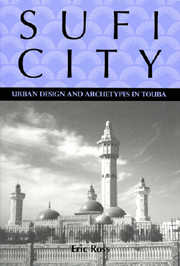Book contents
- Frontmatter
- Contents
- List of Illustrations
- List of Appendixes
- Acknowledgments
- Note on Translation, Spelling, and Transliteration
- Introduction
- 1 Archetypes: Sufi Phenomenology and the Semiosis of Landscape
- 2 Urban Design: The Spatial Configuration of a Spiritual Project
- 3 Marabout Republics Then and Now: Autonomous Muslim Towns in Senegal
- 4 The Pénc: Trees and Urban Design in West Africa
- Conclusion
- Appendix 1
- Appendix 2
- Appendix 3
- Appendix 4
- Appendix 5
- Appendix 6
- Appendix 7
- Notes
- Bibliography
- Index
- Rochester studies in African History and the Diaspora
4 - The Pénc: Trees and Urban Design in West Africa
Published online by Cambridge University Press: 12 September 2012
- Frontmatter
- Contents
- List of Illustrations
- List of Appendixes
- Acknowledgments
- Note on Translation, Spelling, and Transliteration
- Introduction
- 1 Archetypes: Sufi Phenomenology and the Semiosis of Landscape
- 2 Urban Design: The Spatial Configuration of a Spiritual Project
- 3 Marabout Republics Then and Now: Autonomous Muslim Towns in Senegal
- 4 The Pénc: Trees and Urban Design in West Africa
- Conclusion
- Appendix 1
- Appendix 2
- Appendix 3
- Appendix 4
- Appendix 5
- Appendix 6
- Appendix 7
- Notes
- Bibliography
- Index
- Rochester studies in African History and the Diaspora
Summary
Touba's spatial configuration, as described in chapter 2, is clearly well ordered. The layout is neither accidental nor arbitrary and is certainly not “organic” in the sense of having developed incrementally on the ground without overall coordination or planning. On the contrary, the city has develoxped through the consistent and coordinated efforts of a hierarchic and ideologically motivated institution and its design corresponds to a coherent set of planning principals. Foremost among these principles is use of the pénc, or central public square, as a “design idea,” both at the scale of the entire city and of its various wards and neighborhoods. This chapter aims to demonstrate that the pénc is an indigenous Senegambian urban design model and that it is closely connected to the use of trees as civic monuments and institutions. Furthermore, it aims to demonstrate that the very same Sufi-inspired “acts of inhabitation” and ‘acts of will” that created urban form in Touba are operative also in Senegal's other Sufi centers.
The Wolof term pénc designates the central public square of a community. Yet, significantly for our understanding of the relationship between the city of Touba and the arboreal archetype for which it is named, the first meaning of the term pénc is “palaver tree.” A palaver tree is a political institution, part of the public sphere. It is the tree beneath which a community's business is discussed and decisions taken.
- Type
- Chapter
- Information
- Sufi CityUrban Design and Archetypes in Touba, pp. 176 - 215Publisher: Boydell & BrewerPrint publication year: 2006



